Artists have a wealth of tools at their disposal to create magical art pieces, and it’s important to pair these tools with the right art surface for them to shine. One of our favorite surfaces is a sketchbook because of its portability and convenience. Sketchbooks come in all sorts of sizes, paper weights, bindings, and more. We’re here to help you pick out the best one that suits your needs, so keep reading to see some of our favorites.
Sketchbook Considerations
Choosing the right sketchbook depends on knowing how you’ll use it.
Medium
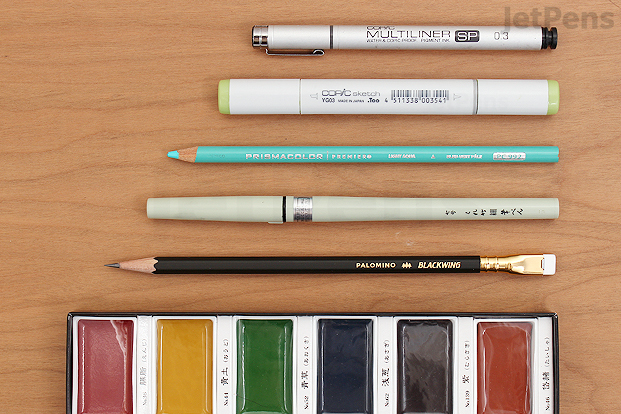
From top to bottom: drawing pen, alcohol-based marker, colored pencil, brush pen, pencil, watercolor palette
Portability
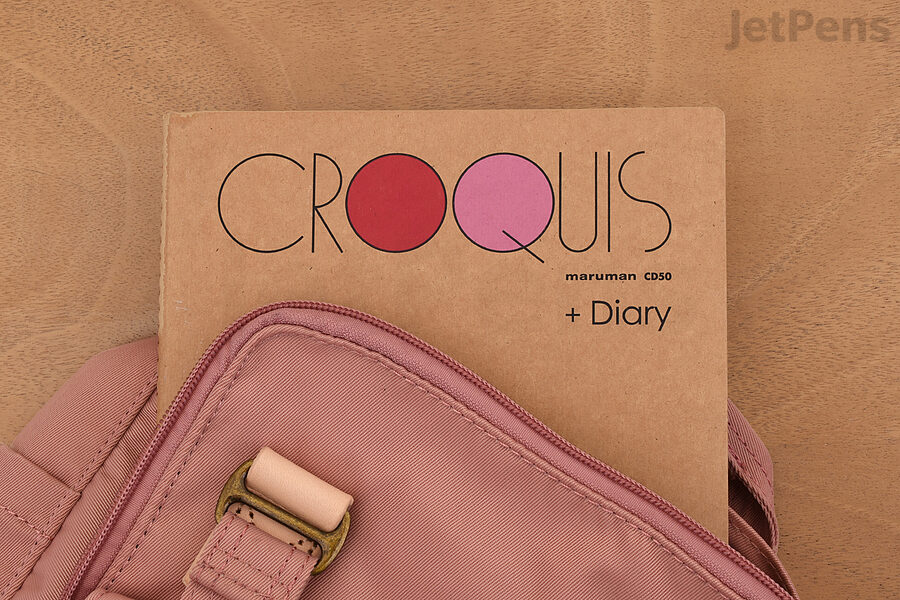
Do you tote a sketchbook everywhere you go, or do you only sit down with it in your studio? Does your sketchbook need to fit in a pocket or a travel bag? The construction of a sketchbook’s binding and cover, as well as its size, are the key factors that decide portability. Look for more durable options like thread or wire bindings and chipboard covers instead of paper.
Level of Artistic Polish

Sketchbooks might be used for rough planning drawings (left) or for elaborate finished pieces (right).
Do you make every page a beautiful work of art, or do you need a space to sketch and doodle plans for pieces you’ll finish elsewhere? Both are perfectly reasonable ways to use a sketchbook, but it’s good to know in advance. Otherwise, you might pick up a fancy sketchbook and be too intimidated to “waste a page” or select a sketchbook with thin paper that can’t support your grand artistic ambitions.
Sketchbook Characteristics
Let’s break down the traits that make a sketchbook suited to different applications.
Size
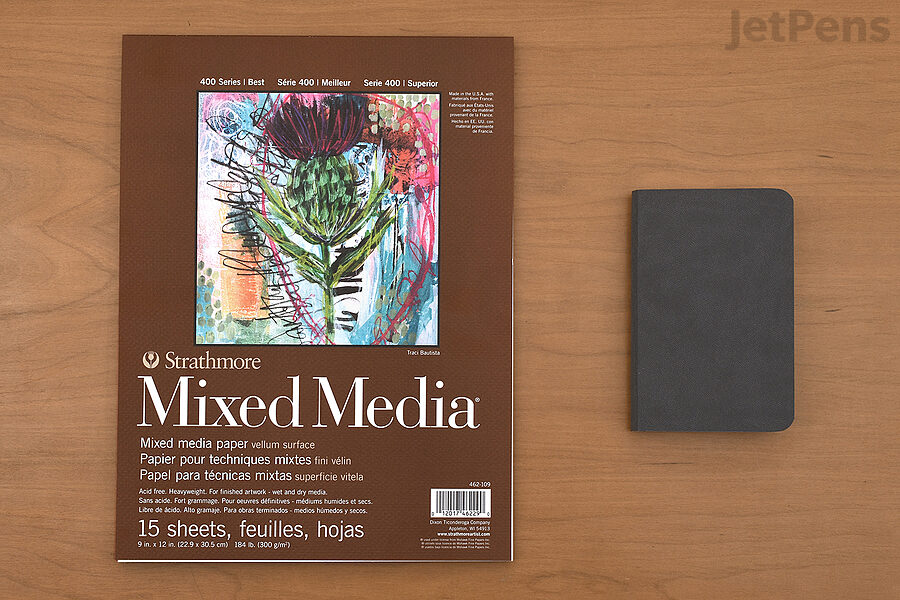
Sketchbooks vary in size and number of pages. Small pocket sketchbooks are nice for carrying around, while larger sketchbooks give artists a bigger canvas for creativity. Sketchbooks with fewer pages are also easier to carry, but some artists prefer having as much paper as possible in their sketchbooks.
Binding and Cover

Other sketchbooks may have spiral or twin-ring bindings. Artists may prefer these bindings since they lay flat and don’t hinder the drawing process. If you like these binding styles but want to be able to tear pages out easily, look for sketchbooks that have perforated pages. Glue binding is the least durable binding style, most often used in pads of paper instead of sketchbooks, but it’s great for cleanly removing pages.
For artists who keep sketchbooks as part of a portfolio, a hard cover can extend the lifespan of a sketchbook. An elastic closure on your sketchbook also helps protect the artwork inside.
Paper Weight

Paper weight is an important consideration—it is often the difference between a wrinkled, crumpled mess or a polished piece. While some brands use pounds (lbs) to delineate paper weight, we prefer using grams per square meter (gsm) because imperial weight (lbs) is more difficult to define and may be inconsistent. The higher the number of gsm, the thicker and sturdier the paper.
Material and Finish

Textured (left) versus smooth (right) paper
There are a variety of terms that can be used to describe texture, including “hot press” or “plate” for smooth papers, and “cold press” or “toothy” for rough papers.
Smooth papers are ideal for drawings with sharp edges and fine details, though they aren’t best for dry media that need to catch in the grain to transfer color. Toothy papers produce textured drawings with vibrant colors, but may leave gaps in the drawing due to the rough surface.
To protect their drawings, artists should look for paper that is acid-free. Acid-free papers tend not to discolor or break down over time, allowing your art to keep its true colors. Paper color also differs across sketchbooks. The most common colors are white, off-white, and ivory. Some specialty sketchbooks may feature toned paper in shades of dark beige, tan, or gray.
Sketchbook Recommendations
Now that we’ve gone over our considerations, let’s take a look at our recommendations for various media.

Stillman & Birn makes a wide array of specialized papers for sketching, and the Zeta sketchbook is our favorite for all-purpose use. With its heavy weight and smooth finish, this sketchbook lends itself well to almost any media and the true white paper showcases colors faithfully. The sketchbook is available in four sizes, each with a sturdy cover and binding.
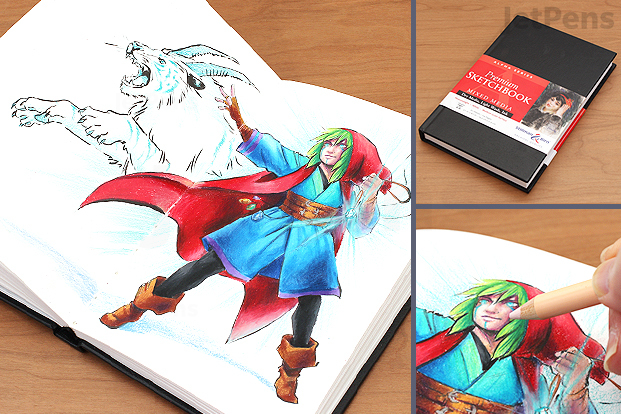
Dry media will work on most surfaces, but we recommend choosing a relatively smooth paper with some tooth. If the paper is too smooth, the pencil will streak or look washed out; if it is too rough, the pencil will skip. Graphite pencils work best on paper with a bit of texture, since the paper catches the graphite and separates it from the pencil lead. On the other hand, colored pencils generally draw better and have superior color payoff on smoother paper.
The Alpha sketchbook is a joy to use with graphite and colored pencils. The white paper has a mild tooth that catches just the right amount of pigment. It’s heavier than the average sketchbook for dry media, but this makes it versatile as you can use it with light washes of ink or watercolor. If you prefer ivory paper, the Gamma sketchbook has the same weight and tooth. If you want smoother paper for colored pencils, you can opt for the Epsilon sketchbook instead.

The Strathmore 400 Series Mixed Media Pad is filled with smooth heavyweight paper. Its mixed media capabilities allow you to soak a page with an ink wash or layer watercolor over your lines. For strong black lines and spot fills, be sure to work with opaque ink.
The Mixed Media Pad is also available in black, and it’s our recommendation for the best black paper sketchbook.
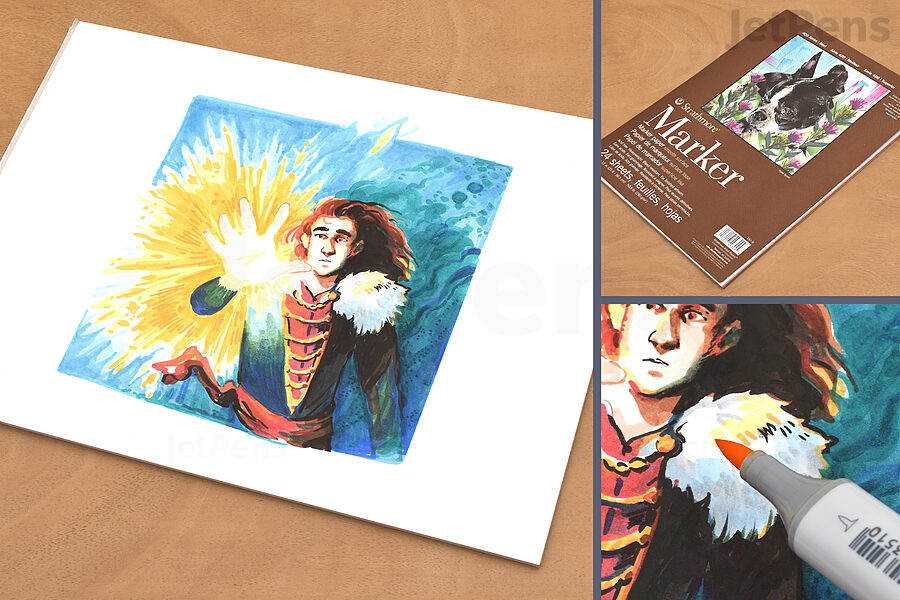
The smooth paper of a Strathmore 400 Series Marker Pad is great for alcohol ink. Strokes don’t spread, colors don’t streak, layers build easily, and blending is almost effortless. Heavy layering does cause bleedthrough, but it’s easily fixed by removing a sheet from the glue binding and working on a protected surface, or by keeping scrap paper between pages.
For a more portable option, pick up a Copic Sketchbook. Although it’s filled with slightly thinner pages, lines don’t feather and colors stay vivid. Plus, its durable twin-ring binding and two small sizes make it easy to take on the go.

This heavyweight acid-free cold press paper is designed especially for use with watercolors. The textured surface takes color brilliantly but is smooth enough that you can blend and reactivate paints well. Available in three sizes, each sketchbook has a durable hard cover and sturdy twin ring binding to take along on your adventures.
If you would like to paint with your watercolors peacefully at home, Global Art Fluid 100 Watercolor Paper Easy-Blocks contain 100% cotton paper with glued binding on two edges to prevent the paper from buckling when wet. Since the binding is very secure, take care when removing your work from the block.
If you’re looking for a smaller watercolor sketchbook or one with a sewn binding, the Stillman & Birn Beta Sketchbook contains extra heavyweight paper that’s perfect for layering watercolors with no bleeding, streaking, or pilling. The Delta series contains the same paper in ivory.
Disclaimer: all images are owned and copyright by their respective owners and website (www.jetpens.com) and “https://madcity.supplies/blog” is for news, information, product news and reviews.


